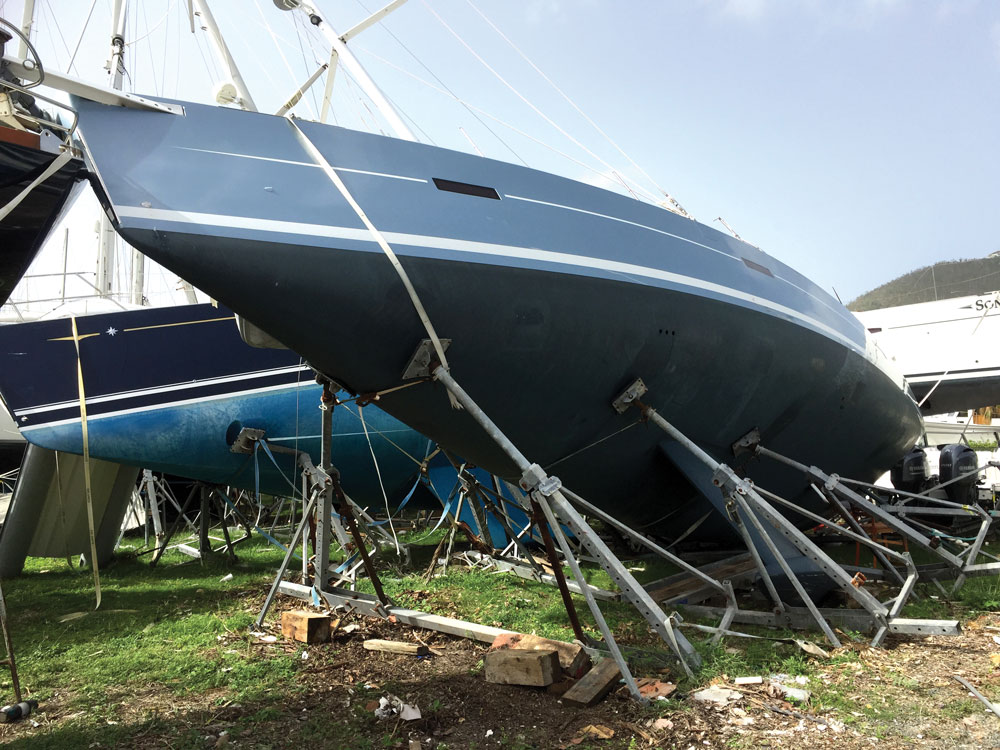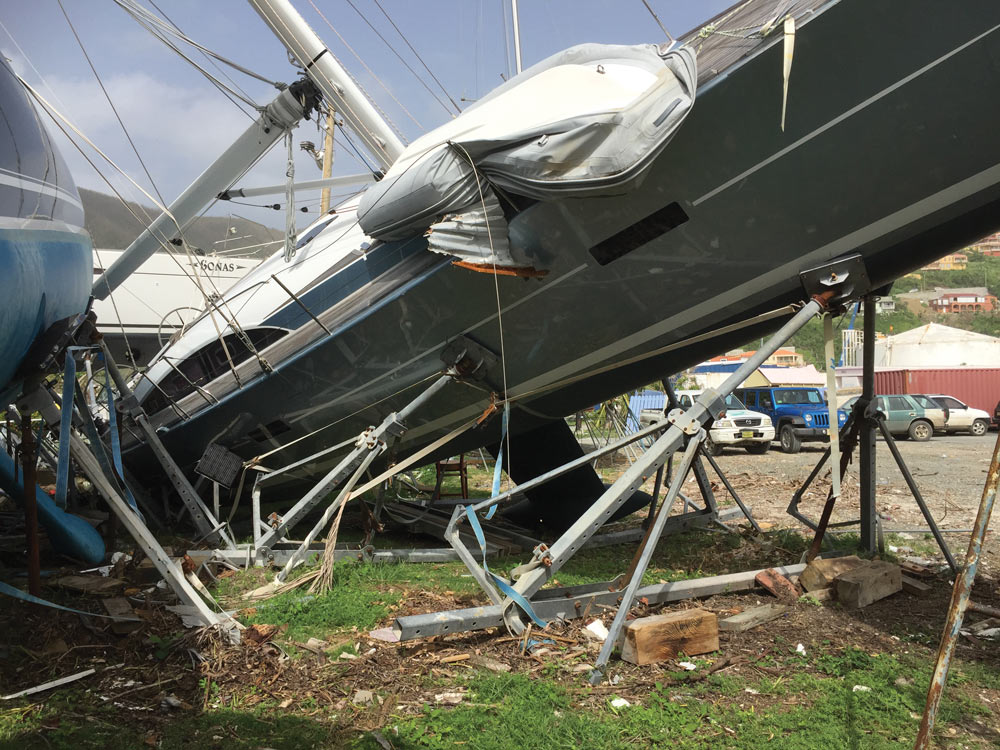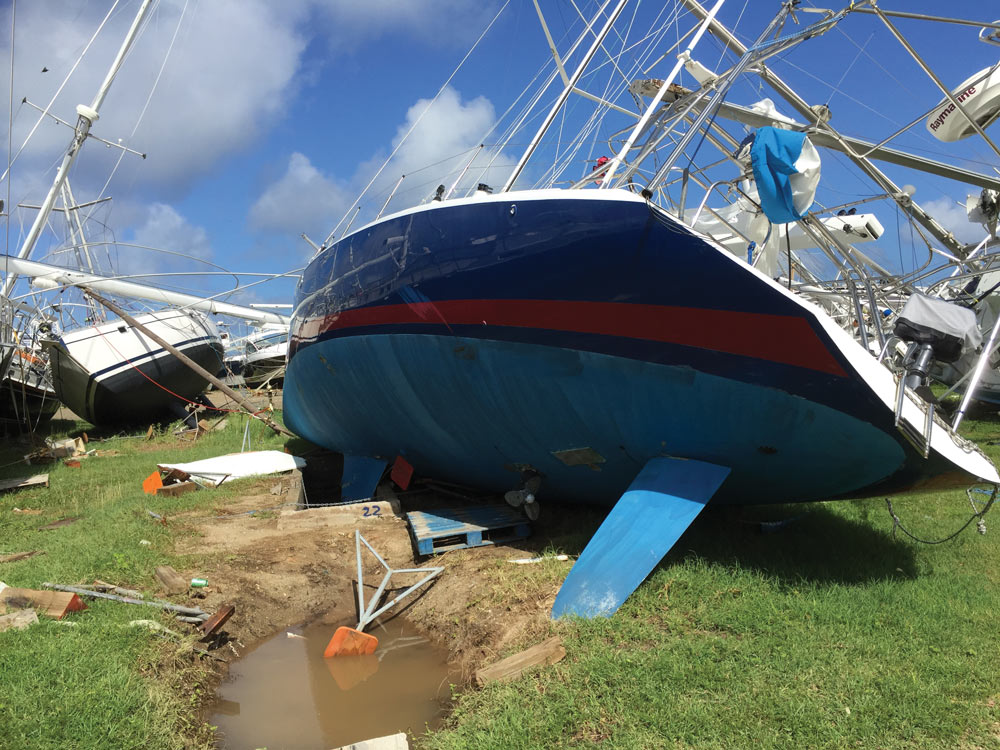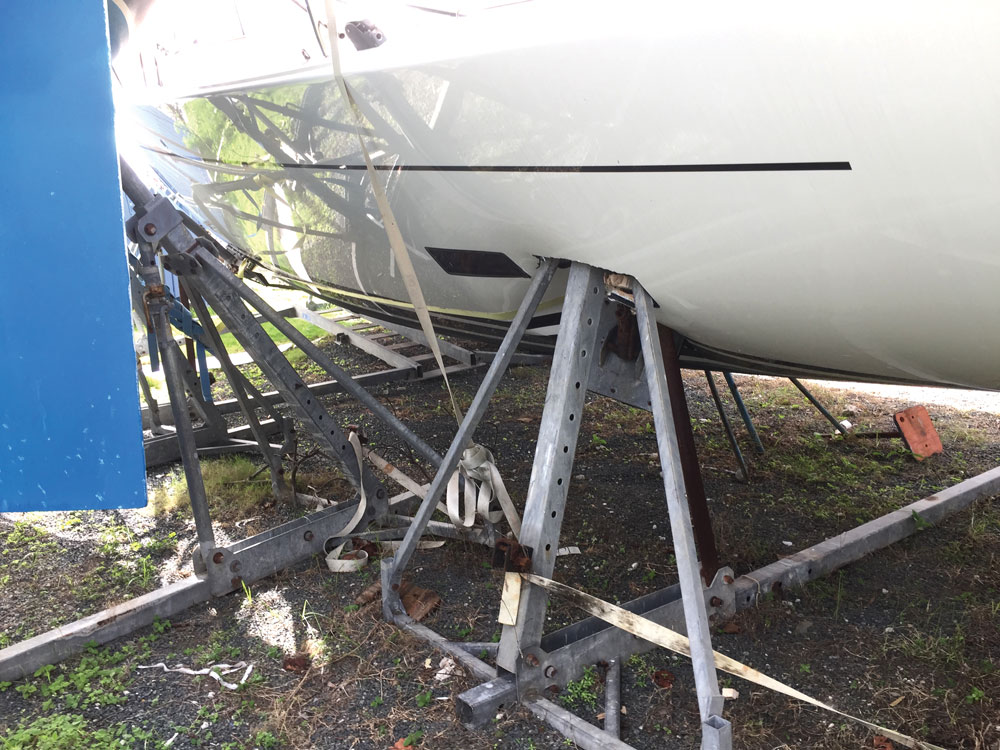
On September 6, 2017, an unprecedented event occurred in the British Virgin Islands when Hurricane Irma, the strongest recorded hurricane to make landfall in the Western Hemisphere, passed directly over the island chain. Two weeks later, Category 5 Hurricane Maria passed just south of the islands, and the combination of these two tempests produced widespread destruction to many hundreds of boats — charter yachts and private vessels — stored in these islands.
As a requirement of the various insurers, a number of “hurricane plans” have been employed in an effort to minimize risk to the vessels stored here during the summer months. As a marine surveyor, after the hurricanes I had the opportunity to see which preparations allowed boats to survive these hurricanes, or in many cases, to note the damages that occurred due to failures of the methods used to prepare them.
What Worked, and What Didn’t
For decades now, where vessels are stored on land, an increasing number of boats have been “strapped down” with polyester straps to anchor points on the ground. This method has been used in conjunction with jack stands and cradles, and with vessels lowered into “hurricane pits.” While strapping the boats down may have helped, in many cases the polyester straps (which can stretch as much as 5 to 15 percent under load) allowed for significant movement under the tremendous pressure from the winds, causing the stands to collapse. Or, the straps themselves stretched to the point of failure, tore out their anchor points on the boats (cleats or bollards) or were ripped from the ground.

In other instances, where the anchor points held and the cleats did not fail, the downwind sides of the boats often sustained damage from the stands or adjacent vessels being pushed into their hulls. (When the eyewall of the storm passed, the wind direction reversed, which meant boats went down in both directions.) Because these straps stretched so much in the 200-plus mph winds, in some cases, using chains, wire rope or perhaps one of the ultra-low-stretch synthetics, such as Dyneema, would have been far more effective.
However, even some of the vessels secured with chains and wire suffered damage. When placing supports and anchor points, oftentimes little attention was given to the considerable side forces (the idea was to keep boats in position solely using downward pressure). So, regardless of whether polyester strapping, wire or chain was used, increasing the size and number of the anchoring systems and placing them farther away from the hulls to help prevent side movement might have been more effective.

However, even some of the vessels secured with chains and wire suffered damage. When placing supports and anchor points, oftentimes little attention was given to the considerable side forces (the idea was to keep boats in position solely using downward pressure). So, regardless of whether polyester strapping, wire or chain was used, increasing the size and number of the anchoring systems and placing them farther away from the hulls to help prevent side movement might have been more effective.
In Tortola’s Nanny Cay Marina, quite a few boats were stored in “Lloyd’s-approved cradles” — substantial bolted-together affairs that are widely accepted to be the strongest type of system for securing boats stored above ground. However, even these heavily constructed cradles failed under the intense pressure of Hurricane Irma’s punishing winds. Again, the synthetic strapping was likely the culprit, allowing too much movement and exerting tremendous pressure against the leeward supports.
However, in some cases, the cradles held, but because the cradle support arms cannot always be adjusted fore and aft to support the hulls correctly at bulkheads, the hulls of some vessels fractured from point loading of the unsupported hull sections against the unyielding cradle supports. It also appeared at some yards that tripod support stands had not been placed correctly on bulkheads, causing jack stands or cradle arms to be impaled in the hulls. Straps that failed to immobilize the vessels were also, again, a factor.
Most hurricane plans are designed to support a vessel in an average to strong hurricane, but virtually nothing in place in the path of Hurricane Irma was strong enough because the force of the wind increases exponentially as it builds, especially when it reaches historic proportions.
Let’s take the example of a 40-foot yacht with a hull that’s 5 feet tall, including the cabin trunk. It presents a surface area of 200 square feet (a bit more, actually, if taking into account the mast and rigging). The math to determine wind force is complicated, but the side-load calculator provided on the website of the Sound Cedar building company will suit our purposes.
Using this calculator, in order to withstand a 100 mph wind, the straps and supports for our vessel must be capable of withstanding a wind load of 9,250 pounds. This force is easily within the range of what is currently in use at most boatyards with jack stands, sand screws and polyester straps. But what happens when the wind force jumps to 200 mph? At this speed, the force on the hull is now 37,000 pounds, and in Irma, with recorded gusts as high as 256 mph, the wind force is 60,000 pounds! So it’s no mystery why so many boats were knocked down or dismasted in that catastrophic storm. Still, making sure that the base for your straps or chains is far enough away from the hull will significantly reduce side-force movement. Consider your strapping anchor points to be similar to a rig’s shroud base: The farther outboard the chainplates are from a mast, the more substantial the support.

In Vuda Point, Fiji, backhoes are used to dig custom pits for each vessel. Then, instead of solid stands or blocking, used truck and car tires are placed around the perimeter of the boat to support it. With these “soft-sided” pits, even though the straps may stretch, the boats can move with the wind without sustaining damage, which has proved to be very successful, especially when rigs are left up.
There is a trend in some areas to require that a vessel have its mast(s) removed in an effort to reduce windage while in storage. I do not, however, think it can be unequivocally said that in cases where a vessel is left on stands or in cradles, the windage of a sailboat’s mast and rigging was the reason for the failures of the support systems employed by the various boatyards. Undoubtedly, when preparing to leave a boat in a hurricane- or cyclone-susceptible region, reducing windage is a good idea. But in cases with support structures, whether they be straps and cradles or in pits lined with tires, if the support is substantial enough, then removing the mast(s) might not be necessary.
However, the mast and its windage should be taken into account when calculating the measures needed to ensure that the vessel is properly supported for its storage session.
Summing Up
Having witnessed and survived the unprecedented 2017 Caribbean hurricane season, it’s clear to me that no single method of preparation could be absolutely guaranteed to prevent damage to a yacht stored on land. But there are lessons for owners pondering the options for leaving their vessels in boatyards susceptible to tropical systems.
- Reducing windage is vital, so of course, removing all sails and canvas is a given. Taking the next step, by removing the mast or lowering the vessel into a pit, or even just removing the boom and canvas frameworks, helps reduce wind loads.
From my observations, I don’t believe that the windage from a standing rig was the culprit in the failures of support systems in the various boatyards. If the support system is strong enough, masts can stay in boats.
Unyielding stands or supports are of no use if the vessel is improperly blocked or if the strapping supports allow for substantial stretch, and it is vitally important to make sure that the anchor points for your straps, chains or wires are spread far enough apart that they are effective in preventing sideways movement.
Employing “soft” hurricane pits with tires in the perimeter might be the most effective manner of supporting a vessel during a hurricane, especially if its mast remains up. But keep in mind the issue of potential storm surge in your area. A vessel in a pit will be more likely to float away than one firmly blocked a few feet higher should the boatyard be flooded.
If a vessel is to be strapped down, sufficient low-stretch strapping must be present to allow for a safety margin to encompass the highest amount of wind force that a hull and rig might encounter (two 10,000-pound straps on each side of a 50-foot boat is not enough, and four on one side might still be insufficient in 200-plus mph hurricane winds).
Ask your boatyard to run the wind-force calculations for your particular vessel to ensure an adequate safety margin is allowed for.
When supporting your vessel — by jack stands, a cradle or truck tires — be sure to place the supports at bulkheads or other strong points of your hull. Tap around the bottom of your hull with a phenolic hammer to find these strong points. Be sure to check the interior to make sure you are not going to be point loading an area that might not be able to withstand tremendous pressure. Small partial bulkheads or furniture might “sound” solid, but are not capable of withstanding high structural loads.
No matter what preparations you make, understand that even the best efforts might not be enough to prevent a total loss of a vessel. Make sure you carry sufficient insurance, that your insurer is in agreement with your storm plan and, as a final measure, take any personal mementos or special possessions off the boat and store them somewhere safe. Memories last forever, but your boat might not.
Frequent CW contributor Todd Duff is a SAMS-accredited marine surveyor based in the BVI and is also a cruising writer and author of the new sailing adventure novel Kidnapped from the Caribbean, available from Amazon and other booksellers.








